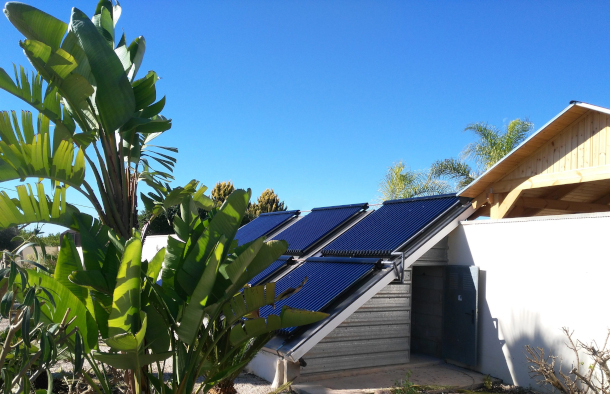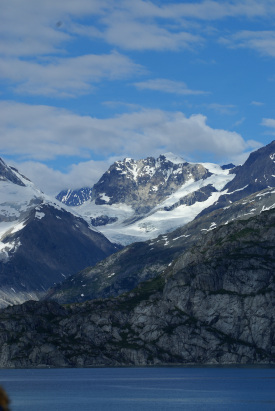Beyond the Headlines
Air Date: Week of December 1, 2023

The Environmental Protection Agency has proposed new drinking water standards for six forever chemicals. (Photo: r. nial bradshaw, Flickr, CC BY 2.0)
This week, Living on Earth Contributor Peter Dykstra joins Host Jenni Doering to share some good news about regulations on PFAS “forever” chemicals. Also, a new freshman dorm at Creighton University in Omaha, Nebraska uses updated rooftop solar thermal technology to heat water. And in history, they look back to a major Alaska public lands bill that protected 100 million acres in 1980.
Transcript
CURWOOD: It’s Living on Earth, I’m Steve Curwood.
DOERING: And I’m Jenni Doering, and it’s time now for look beyond the headlines with Living on Earth contributor Peter Dykstra who joins us from Atlanta, Georgia. Hey there Peter, how ya doin’ this week?
DYKSTRA: I'm doing well Jenni and I hope you are too. And we're going to start out with a little collection of good news on PFAS so called forever chemicals.
DOERING: Say what good news on PFAS? Peter?
DYKSTRA: You know, PFAS is a big problem but the good news is that the big problem is being confronted more and more. For one thing, the US Environmental Protection Agency has proposed new PFAS drinking water standards. And if they're adopted, there would be just a sea change, pardon the pun, in the way the drinking water is tested and treated all over the US. There have been a lot of states that have jumped ahead of federal regulation. Most recently, the state of Minnesota, which passed some of the most comprehensive PFAS bans in all of the states. Others are soon to follow and maybe even surpass the state of Minnesota, which of course we should remember is the land of 10,000 lakes.
DOERING: Yeah they got a lot of water there, Peter so let's hope we don't pollute it. And please remind us what are some of the concerns associated with these so called forever chemicals?
DYKSTRA: Potential cancer causers, potential disruption of reproductive processes, some fairly scary things. And those scary things being confronted by good news is why we want to make sure the good news is known and out there and reported.
DOERING: Well, I'm hoping you might be able to keep the good news going for us Peter. What's next?

These rooftop units utilize sunlight to heat water for indoor use. (Photo: PeterVauhn, Wikimedia Commons, CC BY-SA 4.0)
DYKSTRA: This is a little bit of good news that builds on a technology that's over 40 years old. Out in Creighton University a school in Omaha, Nebraska, there's a passive solar water heating system going on the roof of a new 400 student dorm on the Creighton campus. The energy system will warm water thermal energy can be a help in heating water that's used by the 400 students. It's a freshman dorm, so the freshmen get the good stuff first, sorry, upperclassmen. It becomes very, very clear that these vacuum sealed glass tubes are converting the sun's energy into heat instead of converting it to electricity. It's a carbon free system as well. But here's something to build on- more than 40 years ago, there was a passive solar water heating system placed by President Jimmy Carter on the White House roof. It was good for show, it was a nice symbol. Truth be told, it didn't do a whole lot they're basically small aluminum bathtubs that let the sun heat water, it was then run through the White House to help save a little bit on hot water heating costs.
DOERING: Well, so this sounds like maybe what's old is new, Peter?

523,000 acres were added to Glacier Bay National Park with the 1980 Alaska National Interest Lands Conservation Act signed by President Jimmy Carter. (Photo: Randy Roach, Wikimedia Commons, CC BY-SA 2.0)
DYKSTRA: It is and we've got something from that same era, the Jimmy Carter administration to talk about in our history item this week.
DOERING: All right. Okay, go ahead.
DYKSTRA: December 2, 1980. President Jimmy Carter signed the Alaska Lands Bill, that's the nickname for the Alaska National Interest Lands Conservation Act, or a ANILCA if you want to lousy acronym. Roughly two thirds of Alaska, about 222 million acres are either owned or managed by the federal government ANILCA added 100 million acres to add up to that 222 total. That includes national parks, national wildlife refuges, preserves and other areas that help maintain Alaska as a mostly pristine state.
DOERING: Well, those public lands up in Alaska just sound amazing, Peter. I have to say I've never been but it's on my list for sure. Thanks so much Peter. Peter Dykstra is Living on Earth's contributor and we'll talk to you again next time.
DYKSTRA: All right, Jenni. Thanks a lot, talk to you soon.
DOERING: And there's more on these stories on the Living on Earth website that's LOE dot ORG.
Links
Environmental Health News | “Minnesota Enacts Nation’s Broadest Ban of “Forever Chemicals””
Learn more about the Alaska National Interest Lands Conservation Act (ANILCA)
Living on Earth wants to hear from you!
Living on Earth
62 Calef Highway, Suite 212
Lee, NH 03861
Telephone: 617-287-4121
E-mail: comments@loe.org
Newsletter [Click here]
Donate to Living on Earth!
Living on Earth is an independent media program and relies entirely on contributions from listeners and institutions supporting public service. Please donate now to preserve an independent environmental voice.
NewsletterLiving on Earth offers a weekly delivery of the show's rundown to your mailbox. Sign up for our newsletter today!
 Sailors For The Sea: Be the change you want to sea.
Sailors For The Sea: Be the change you want to sea.
 The Grantham Foundation for the Protection of the Environment: Committed to protecting and improving the health of the global environment.
The Grantham Foundation for the Protection of the Environment: Committed to protecting and improving the health of the global environment.
 Contribute to Living on Earth and receive, as our gift to you, an archival print of one of Mark Seth Lender's extraordinary wildlife photographs. Follow the link to see Mark's current collection of photographs.
Contribute to Living on Earth and receive, as our gift to you, an archival print of one of Mark Seth Lender's extraordinary wildlife photographs. Follow the link to see Mark's current collection of photographs.
 Buy a signed copy of Mark Seth Lender's book Smeagull the Seagull & support Living on Earth
Buy a signed copy of Mark Seth Lender's book Smeagull the Seagull & support Living on Earth

